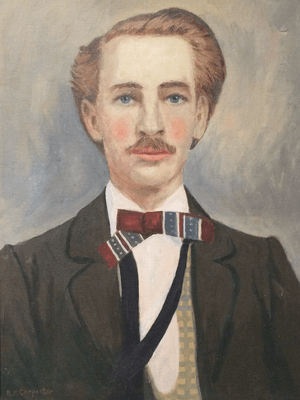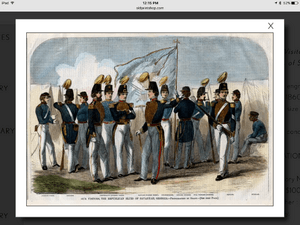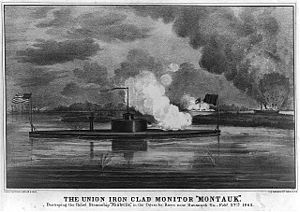George Wayne Anderson facts for kids
Quick facts for kids
Major George Wayne Anderson Jr
|
|
|---|---|

George Wayne Anderson
|
|
| Born | August 5, 1839 Savannah, Georgia |
| Died | August 10, 1906 (aged 67) Savannah, Georgia |
| Place of burial |
Laurel Grove Cemetery, Savannah, Georgia
|
| Allegiance | |
| Service/ |
|
| Years of service | 1861–1865 (CSA) |
| Rank | |
| Commands held | 1st Georgia Volunteer Infantry Co C, The Savannah Republican Blues Chatham Artillery Fort McAllister |
| Battles/wars | American Civil War |
Major George Wayne Anderson Jr. (born August 5, 1839 – died August 10, 1906) was an important officer in the Confederate States Army during the American Civil War. He led a group called the Republican Blues and later took charge of Fort McAllister near Savannah, Georgia. This fort was captured by Union forces in 1864.
Contents
Early Life and Military Service
George Wayne Anderson Jr. went to the University of Virginia from 1856 to 1859. In 1861, he joined the Georgia 2nd Infantry Company, known as the Republican Blues. He started as a second lieutenant.
The Republican Blues was a military group formed in Savannah way back in 1806. They had served in the War of 1812 in Florida. Unlike many Confederate units that formed quickly for the Civil War, the Republican Blues had been around for over 50 years. They recruited members from well-known families in and around Savannah.
In 1860, before the war, the Republican Blues even visited New York City. They were hosted by similar groups there, and everyone showed a lot of goodwill. After the Civil War, the Blues continued to serve as part of the Georgia National Guard. They fought in all of America's wars, except the Spanish–American War.
Anderson was promoted to lead the Blues in 1862. This happened after his uncle, John Wayne Anderson, retired. It's interesting that the Blues served under the U.S. flag before the war, fought against it, and then continued to serve the reunited nation afterward.
Civil War Battles and Fort McAllister
In 1862, Major Anderson and the Republican Blues were sent to Fort McAllister to make its defenses stronger. This meant he rejoined his older brother, Colonel Robert H. Anderson. Robert was leading the fort's soldiers before he was promoted to lead the 5th Georgia Cavalry.
George Wayne Anderson took command of Fort McAllister after Major John B. Gallie died on February 1, 1863. Fort McAllister was one of three forts protecting Savannah, Georgia. The other two were Fort Pulaski and Fort James Jackson. These forts stood strong against the Union Navy's attempt to block trade to Confederate ports.
The coast of the southeastern United States became a testing ground for new naval cannons and coastal defenses. Fort McAllister was very important because it guarded the way to Savannah. Savannah was one of the most vital Confederate ports on the Atlantic Ocean. The battles fought here were key parts of the war.
Union Attacks on Fort McAllister
Union Navy Commander John Lorimer Worden was put in charge of the new ironclad ship, the USS Montauk. He was ordered to attack Fort McAllister. Ironclads were powerful ships with thick metal armor. This was a chance to test new 15-inch Dahlgren guns and the armor of the Passaic-class ironclads.
On January 27, Rear Admiral Samuel Francis Du Pont sent the Montauk and other gunboats to attack the fort. The Union hoped these new weapons would work as well as they had at Fort Pulaski. At Fort Pulaski, the new guns had destroyed the fort in hours, forcing the soldiers inside to surrender.
However, Fort McAllister was different. After seven hours of heavy firing from the ironclads and mortar boats, the fort only had minor damage. Only three men were wounded. Sadly, the fort's mascot, a cat named Tom, died during the shelling. Today, there's a marker inside the fort in his honor.
The design of Fort McAllister was surprisingly strong. It was made of earth, not bricks and stone, so it could absorb the cannonball impacts. The soldiers could quickly repair it overnight. Imagine how frustrating it must have been for the Union Navy to fire all day, only to see the fort look almost undamaged the next morning! After seven failed attacks over the next year, the U.S. Navy waited for General William Tecumseh Sherman to arrive.
Sherman's March to the Sea
Major Anderson decided to defend Fort McAllister even though he didn't receive orders from General William J. Hardee. General Sherman believed that capturing Fort McAllister was crucial for his entire campaign. It would open his way to the sea and allow his army to get supplies. To lead the attack, Sherman chose his best division, led by General William Babcock Hazen.
General Sherman watched the attack from a place called Cheve's Rice Mill, about three miles from the fort. A staff member, who knew Anderson from childhood, told Sherman, "George Anderson is in command, General, the flag will never be lowered. You will have to capture that fort." He knew Anderson would not surrender, even though his forces were greatly outnumbered.
The Fall of Fort McAllister
Fort McAllister was strong, but it eventually fell. Union forces under General Hazen's 2nd Division attacked from all sides. The 47th and 70th Ohio, and the 90th and 111th Illinois regiments quickly overwhelmed the defenders. The battle ended when Confederate Captain Nicholas B. Clinch was overpowered in fierce hand-to-hand combat.
General Hazen was one of the first Union soldiers inside the fort. He saw both Captain Clinch and Major Anderson fighting bravely. Hazen had gone to West Point with Anderson's older brother, General Robert H. Anderson. So, he knew both the Anderson and Clinch families from Savannah.
Hazen saw Major Anderson, stunned and bleeding, sitting on a wooden crate. He spoke to him, "Major Anderson, my apologies for your rough treatment." Anderson replied, "It's war, General. My men gave it their best, I assure you. These men were not prepared to give you anything." Hazen could see General Sherman watching from the rice mill. He told Anderson, "Get to the rear, George, and report to me later." The capture of Fort McAllister marked the end of Sherman's March to the Sea and the end of the war for Major Anderson.
After the War: Reconciliation
"The fort never surrendered, it was captured by overwhelming force," Anderson later recalled. General Hazen agreed with Anderson's account of the battle. He reported that his forces fought "the garrison through the fort to their bomb-proofs, from which they still fought, and only succumbed as each man was individually overpowered."
Before being taken prisoner, Anderson saw a company of Union soldiers marching out of the fort. They were headed towards some buried explosives that would have blown up under their feet. Anderson quickly took their hand and led them away from danger. Years later, a Union lieutenant named George W. Sylvis remembered this story fondly in a letter to Anderson. This showed how old wounds were starting to heal between former enemies.
With Fort McAllister captured, General Sherman's forces could finally connect with the Union Navy. This allowed them to get much-needed supplies and cleared the way to Savannah. The Confederate leaders realized their situation was hopeless after the fort fell. They moved their remaining forces into South Carolina. On December 22, 1864, General Sherman famously sent a telegram to President Lincoln. He presented the city of Savannah as a Christmas gift.
A Dinner with Generals
On the evening the fort fell, Anderson was held at his family home, Lebanon Plantation. This plantation became General Hazen's new headquarters. General Hazen and Lt. Col. Strong invited General Sherman to dinner to celebrate their victory. In a kind gesture, General Hazen also invited Major Anderson to join the meal, after getting Sherman's approval.
The discussion at dinner was surely lively. Anderson had a strong talk with General Sherman about how the fort was defended. He also spoke about the bravery of all the soldiers who fought there. Cigars were shared, and tributes were made to those who had died.
Major Anderson was sent to several prisons: Hilton Head, South Carolina; Point Lookout, Maryland; and then the Old Capitol Prison in Washington D.C. He was later moved to Fort Delaware. On June 4, 1865, he took an oath of loyalty to the United States and was released under orders from General Ulysses S. Grant. Anderson then returned to Savannah and his home, Lebanon Plantation, which was just up the road from Fort McAllister.
Life After the War
After the war, Major Anderson worked for the W W Gordon company in Savannah. He often entertained people with stories about the war and even about General Sherman, whom he called an 'old rascal'. His older brother, Robert H. Anderson, was appointed by two U.S. Presidents to serve on the Board of Visitors at West Point. Robert also served as Police Chief of Savannah for over 20 years.
George Wayne Anderson died in Savannah in 1906. He is buried near his friend Major Gallie at Laurel Grove Cemetery.
Honoring Captain Anderson
The State of Georgia passed a resolution honoring both Anderson and the soldiers he commanded. It said:
Resolved, that Capt. George W Anderson, Jr., who succeeded Major Gallie in command of that post, for the cool courage and successful defense of Fort McAllister, and the noble band under the wise orders of this youthful Commander, deserve the kind remembrance and grateful feelings of the people of the state.
Images for kids






















